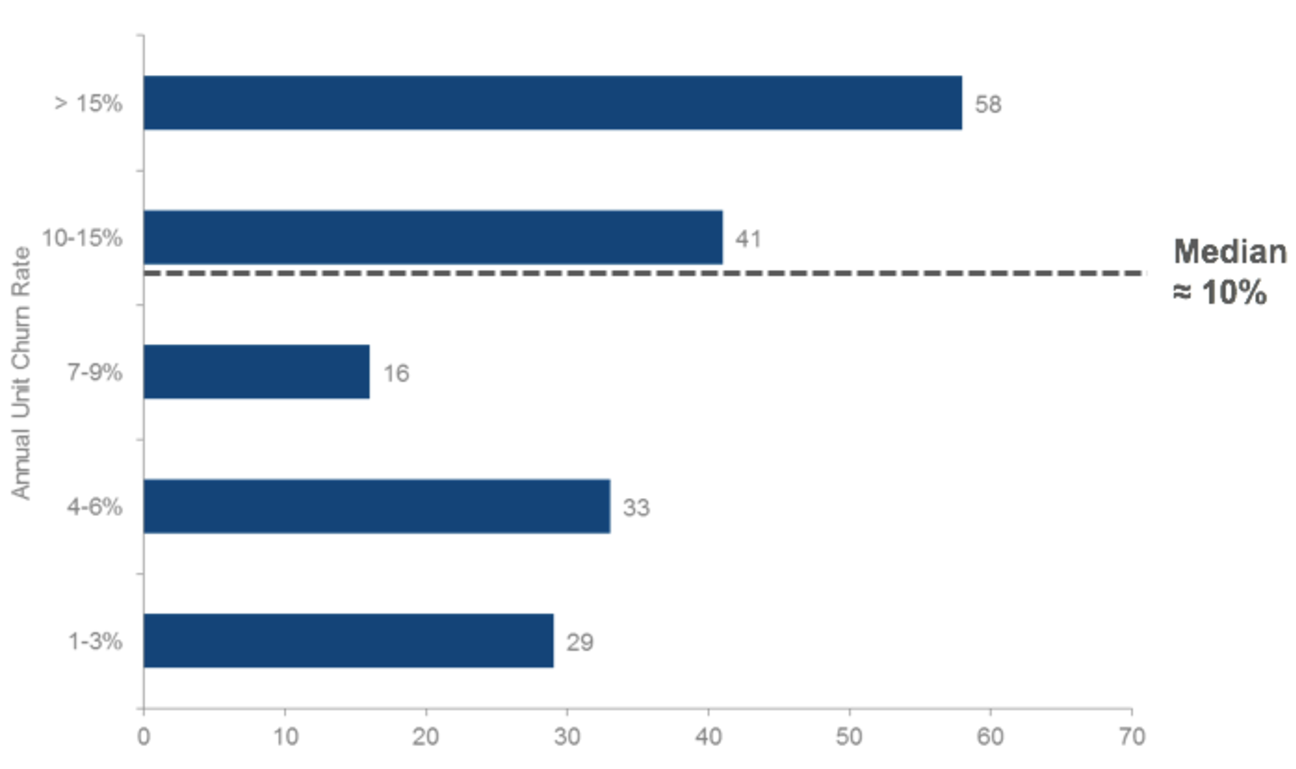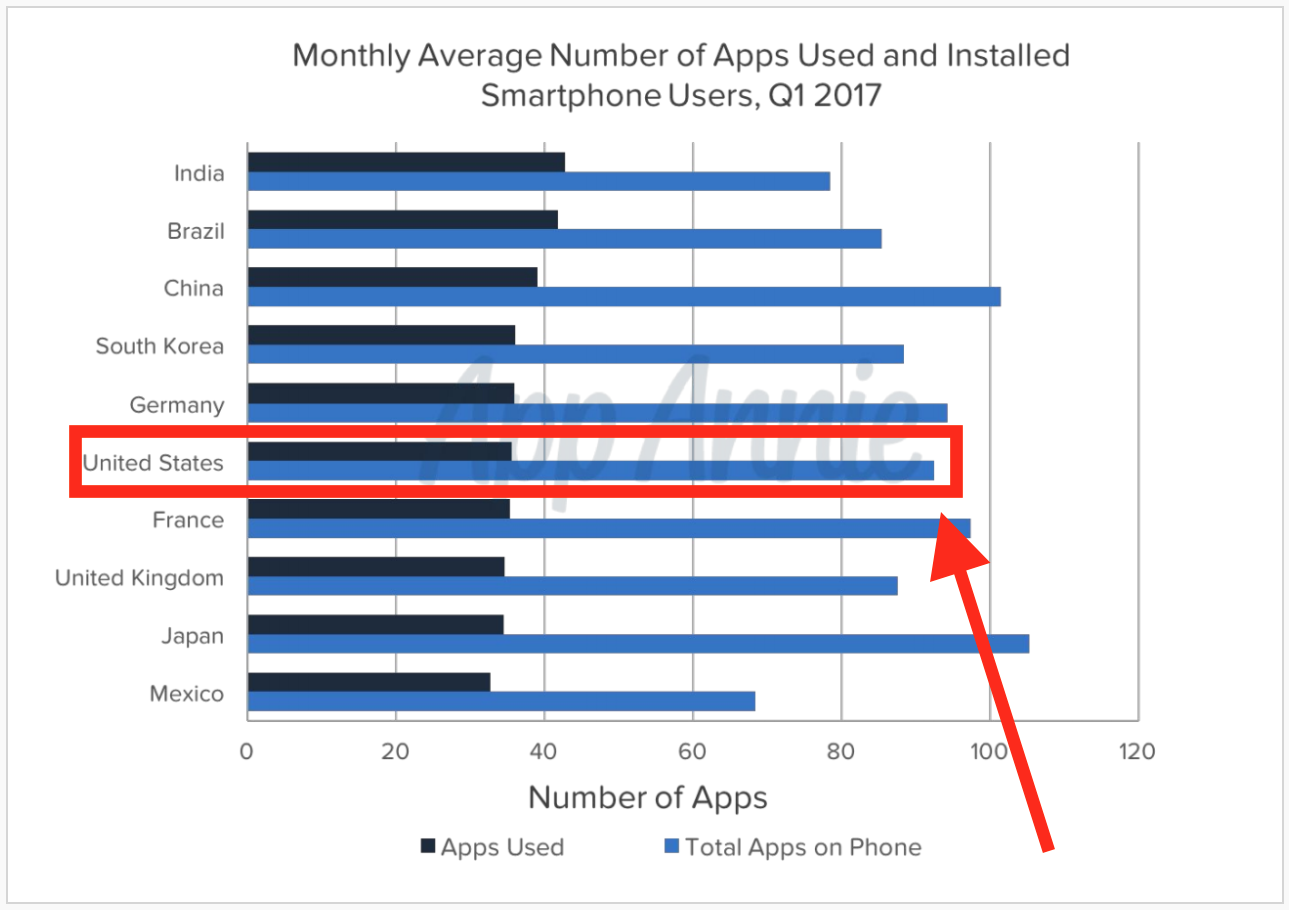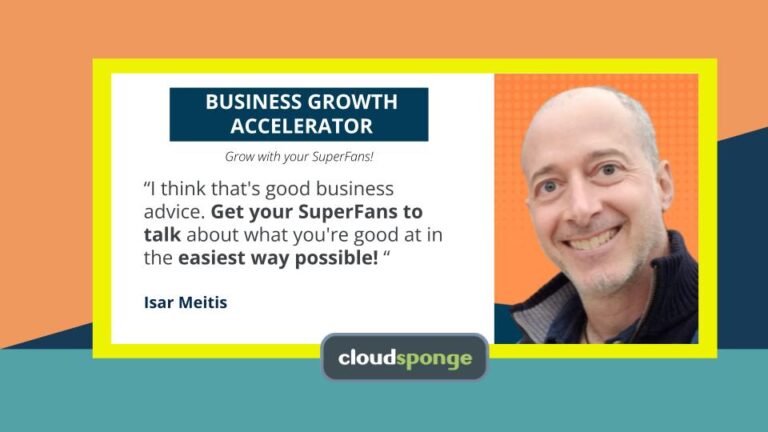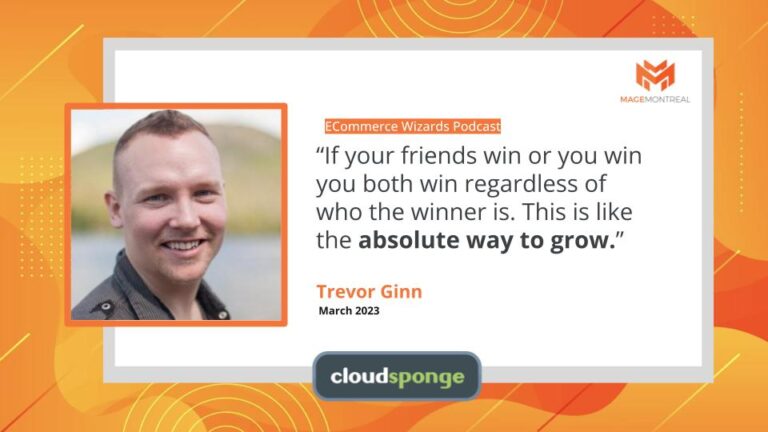As a company looking to attract and retain new users, I’m sure user onboarding is a top priority for you and your team.
After all, you want to get new signups to use your platform and understand its value as quickly as possible, right?
But of course, finding that activation point for your app is far from easy.
And that’s because there are two complex problems underlying user onboarding:
First, is understanding exactly what new users need to do on their very first visit to experience a “magic moment”: the activation point where customers “get it” and fully buy-in to your value proposition.
Second, is figuring out how to make them do it.
Luckily for you, we’ll help you solve for both problems in this post.
This guide will show you:
- Why activation points are critical to your business
- How to identify the activation point for your app
- Successful strategies for guiding users to that activation point
- How to optimize user onboarding for audiences with high churn
Sound exciting? Then let’s dive right in.
Jump to a section:
- What Do We Mean by “Activation Point”?
- How Activation Points Prevent Churn
- How to Define Your Platform’s Activation Point
- Strategies for Leading New Users to Your Activation Point
- How to Improve Low Activation
Skip the Queue - Download our DIY Better Sharing Workbook today!
First, Let’s Be Specific About What We Mean By “Activation Point”
I’ll admit, it might seem like getting people to actually try your app would be the biggest hurdle in growing your customer base.
But that part is actually fairly simple.
That’s because, if you’ve done the market research right, then you know that there’s an audience out there for your platform.
And from there, generating some initial interest is often just a matter of using relevant marketing strategies to drive traffic to your website.
But, it’s right after that initial sign-up where the true challenge lies:
Converting new signups into paying customers.
And that’s exactly where the activation point comes into play.
What is an activation point?
For starters, everyone may not know what the activation point is. If you’re new to the term, this section is for you.
Simply put, the activation point is an action new sign-ups take during user onboarding that helps them understand the value of using a new platform or product.
Or, here’s another way to look at it:
The activation point is the first success milestone for a new user to your solution.
It’s that first big win; the action that uncovers your app’s potential to impact the user’s life in a positive way.
As Kissmetrics so succinctly defined “activation,”
“it’s the first point where you deliver the value that you promised.”
And the trick with it is to make the activation process as smooth as possible.
“Ideally, your product is something people will crawl through broken glass to get to, but it doesn’t hurt to get rid of the broken glass at the very least.”
Then, for your business, the activation point holds a different meaning than for the customer:
It’s your first defense against one of the biggest issues plaguing SaaS companies today – churn.
How Activation Points Stop Churn Dead in It’s Tracks
It’s no secret that churn continues to be a major problem for SaaS companies.
In fact, according to For Entrepreneurs, SaaS churn has increased every year since 2013, reaching a median rate of 10 percent in 2016.
And while any number of factors contribute to customer churn – including price, customer service and perceived ROI – make no mistake:
The beginning of a customer’s experience with your app often dictates whether or not they continue as your customer.
It’s like Lincoln Murphy often says on his blog,
“The seeds of churn are planted early.”
And it makes sense why: in most cases, today’s users have plenty of options when it comes to solving their problems.
Need a project management tool?
There’s Trello, Asana or Flow.
Want a social media marketing platform?
You have Hootsuite and Buffer and CoSchedule to choose from.
And while users interested in a competitive, diverse marketplace might perceive that to be a good thing, here’s the truth:
People actually don’t do well with choices.
An article from Dr. Liraz Margalit in Psychology Today shared some interesting insights into how people actually react when needing to make a decision:
“When we are presented with many options, we usually fear making the wrong decision. This can be translated into simple math – when there are only two options, we have a 50% chance of choosing the right one. But when there are five options, our chances suddenly decrease to 20%.”
And that element of human psychology proves to affect startups in a real way.
Here’s how:
In the first quarter of 2017, your average smartphone user in the U.S. had over 80 apps installed on their phone.
But how many did they actually use in a 30-day period?
Less than half.
That means your app has a 50 percent chance of being abandoned, if you don’t onboard users properly and quickly get them to that activation point.
Why?
Because the activation point demonstrates the value of your platform and helps users decide on a solution (yours, of course) among the sea of other choices.
Want to see it in action? Read on.
A Real-Life Example: How Trello Used a Success Milestone to Gain 19 Million Users
Let’s go back to the project management example for a second:
Imagine you’re a freelancer looking for an easy, customizable tool to manage projects and a friend tells you to check out Trello.
So you create an account, open the app and what do you see?
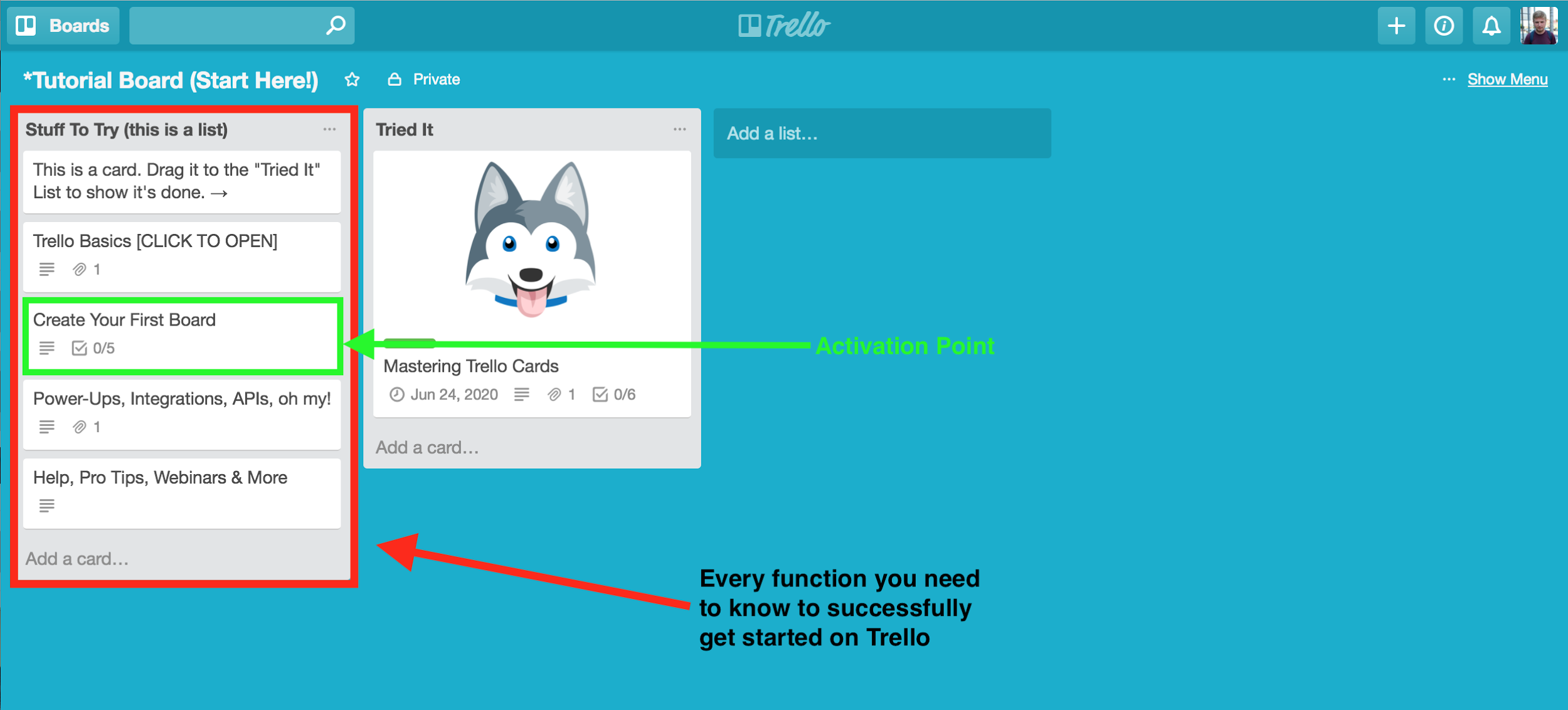
Trello walks new users through onboarding in a pretty creative way: by plugging step-by-step instructions into the tool itself.
So, as you learn about the different functions (like boards, lists, and cards), you’re actually working hands-on with those features.
And, one of the first tasks you’ll complete is actually creating your own “board” – the homebase for a new project or organizing information in Trello.
Pretty brilliant, right?
Now, imagine the alternative.
You’re still a freelancer on the hunt for an organizational tool and your friend tells you to check out Trello.
But instead of walking you through the different features and showing you exactly how to use them, Trello just launches you blind into a blank board and leaves you to figure out the basics without any help.
It doesn’t take much to see why the first example results in far better retention.
Trello identified the activation point for their customers (creating their first board) and walks users through the steps to hit that success milestone, all in the first visit for any new sign-up.
And in doing so, they strip away the user’s need to hunt for alternatives – Trello solves their problem, and in doing so, reduces the need to explore other options.
The result? They are the fastest growing tool in the competitive project management space and Atlassian acquired them earlier in 2017 for $425 million.
Here’s another example:
How Close.io Makes Switching CRMs Simple for New Customers
Close.io markets themselves as a go-to inside sales CRM for startups and SMBs.
And I’m sure you’d agree that’s a crowded market with lots of players – including a few big ones like Salesforce and Microsoft.
So, in order to compete, Close.io had to make sure anyone they could attract to their 14-day free trial immediately saw the value in their platform.
Ty Magnin wrote about how they did it on the Appcues blog:
“When it comes to the onboarding flow, getting new users to import contact and CSV files into the CRM is a key measure of activation—without leads, the value of the product is neutered. By automating how users can important their email addresses and contact lists, Close.io gets new users to the aha! moment of activation that much faster.”
So you see, like Trello, Close.io identified their activation point (importing leads from your CRM and email).
But they take a slightly different (though equally effective) approach to actually moving new sign-ups toward the activation point.
Instead of allowing users to work hands-on in the platform to import leads, Close.io doesn’t launch you into the platform until you’ve hit the activation point.
That means you go live in the platform already having everything you need to see immediate value.
Here’s what it looks like when you sync your email:
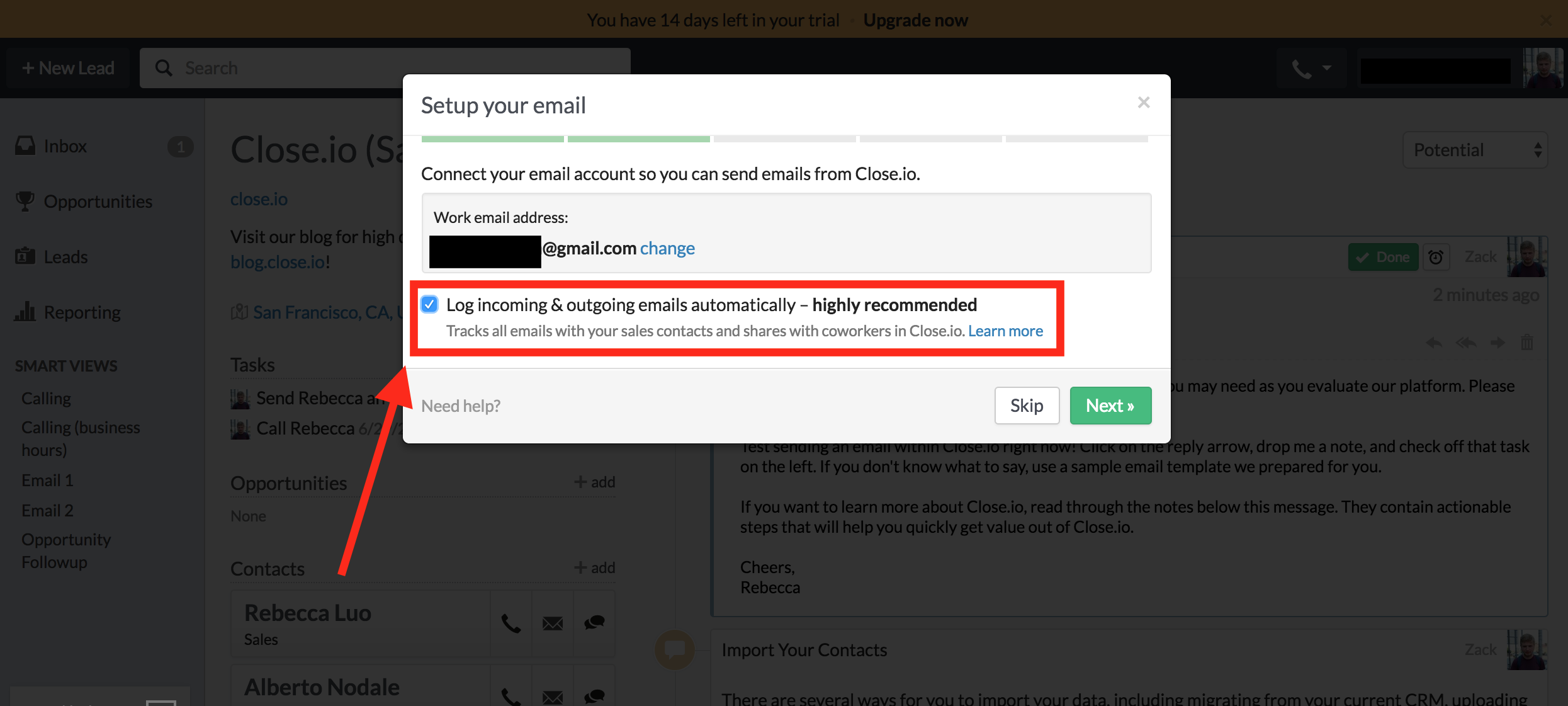
And here’s a look at the prompt to import your CRM data:
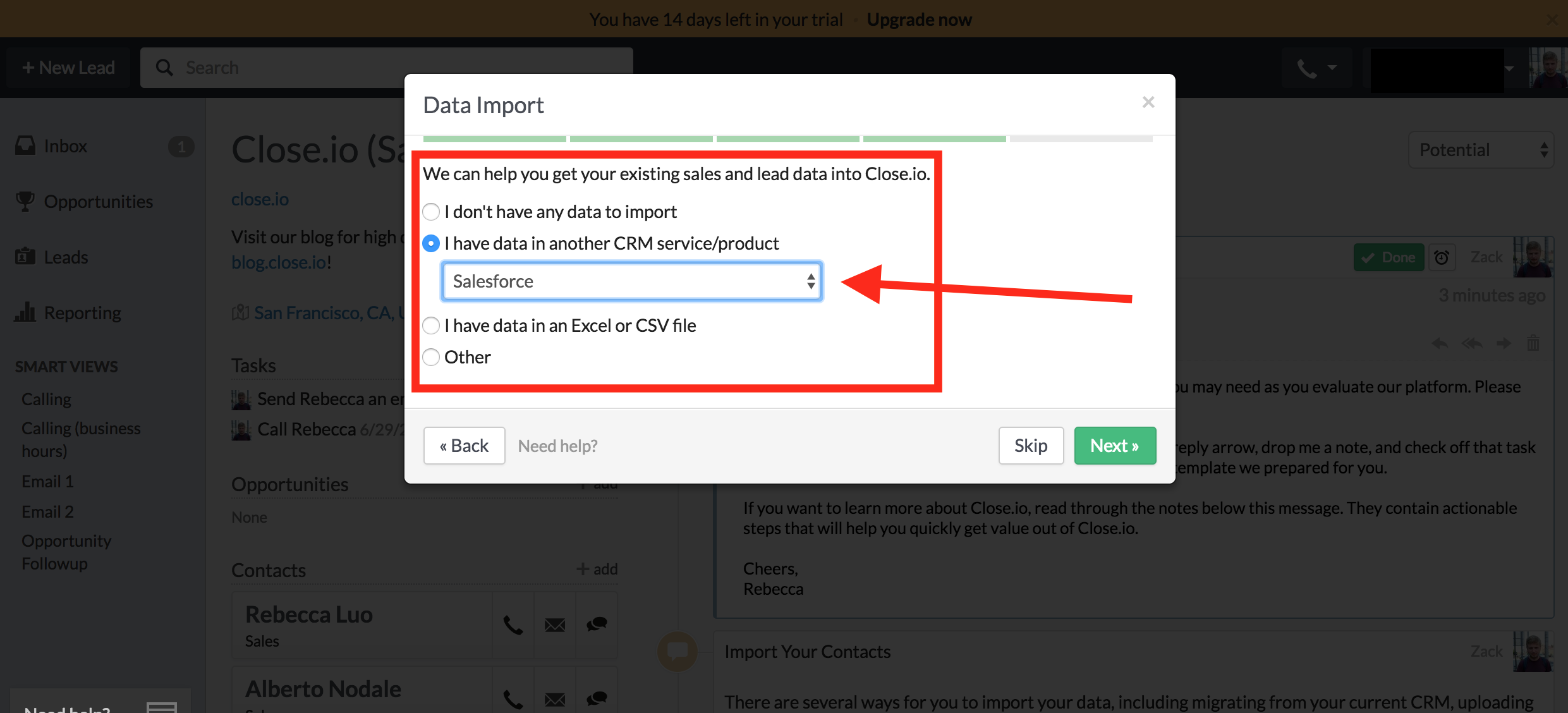
Pretty easy, right?
Twitter Also Understands What Keeps Users Coming Back
With 328 million monthly active users, it shouldn’t be much of a surprise that Twitter knows how to attract (and retain) an audience.
But I’ll bet you’ve never looked at exactly how they show the value of the platform to new users right from the get-go.
And it’s actually a pretty incredible strategy.
As I’m sure you know, all of your activity on Twitter centers around your newsfeed. And the people you follow determine the quality of your newsfeed and how closely they align to your interests.
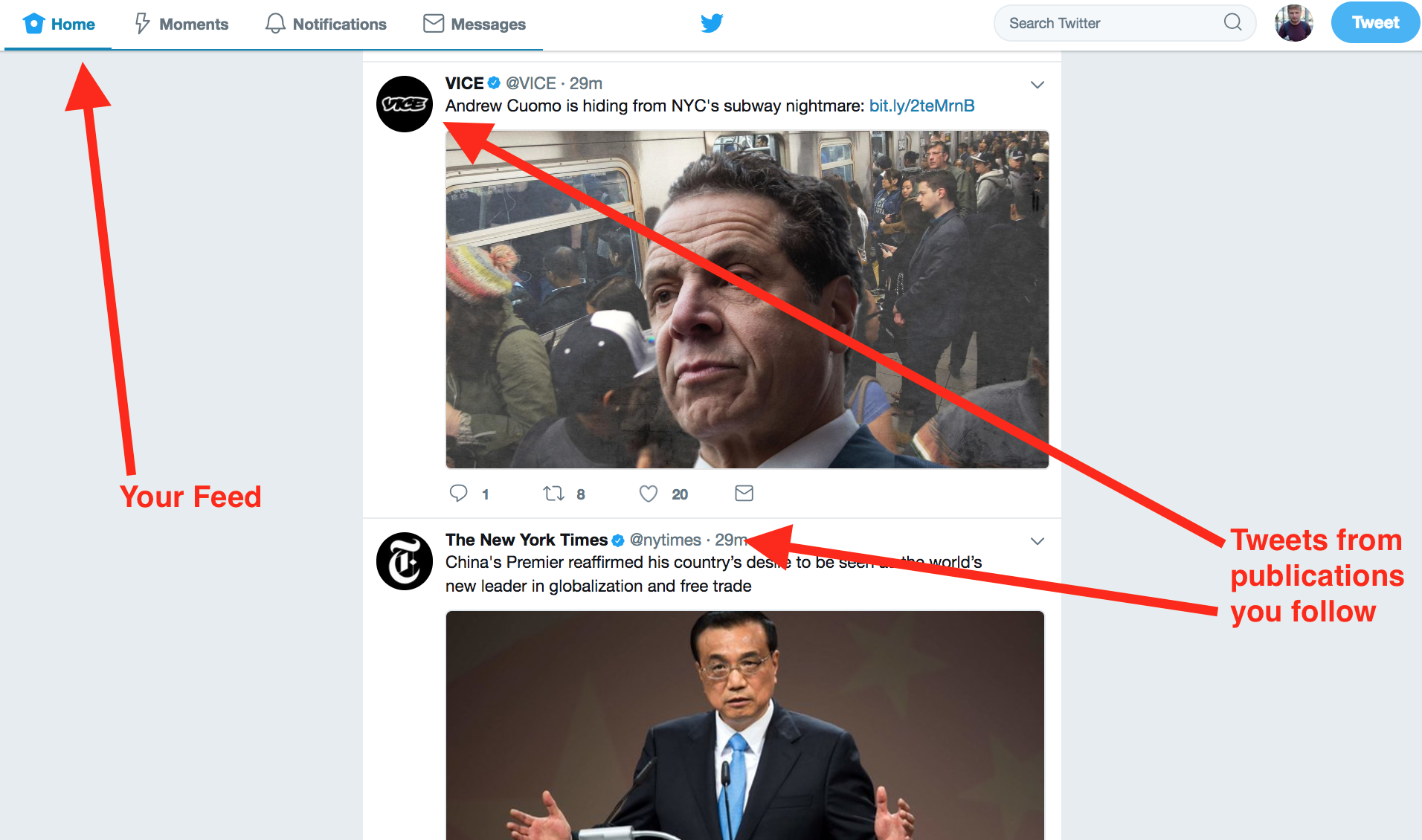
For example, it’s not likely someone interested in foreign affairs would find much value in Twitter if her newsfeed defaulted to following Kim Kardashian and ESPN.
Twitter knows this, and that’s why when you create a new Twitter account, the first thing they ask about for are your interests:
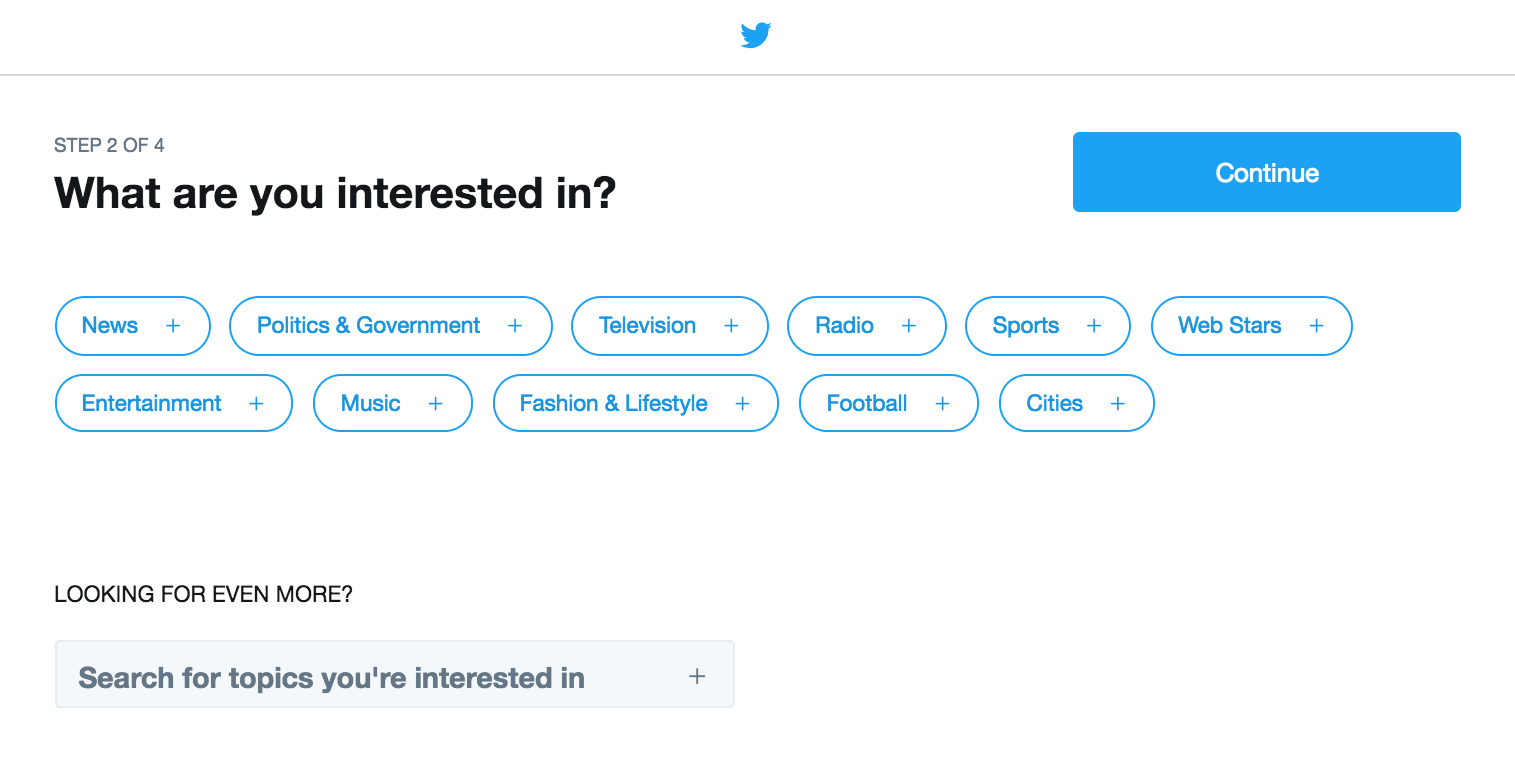
As you choose the broader topics, some more refined ones appear. For example, selecting “News” will drill down into “International News,” “Journalists,” and a few other options.
Then, Twitter takes things a step further by prompting you to import your address book:
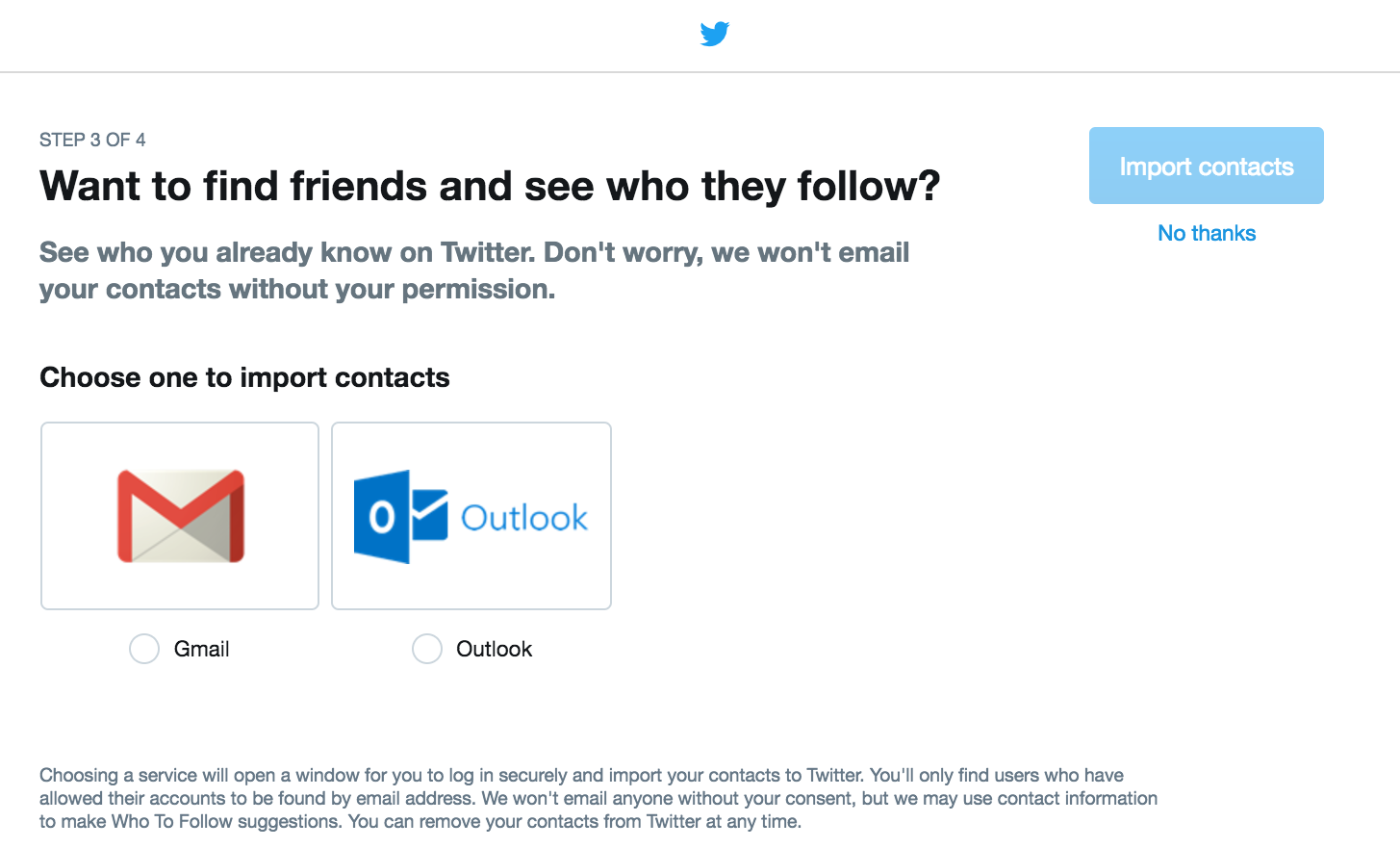
This is a brilliant addition to user onboarding because it automatically connects you with the people you’re likely to want to follow as a new Twitter user: friends, family, and colleagues.
And here’s the last step:
Based on the interests you originally selected, Twitter recommends users to follow.
And unlike importing your address book, this part isn’t optional.
Like Close.io, Twitter requires you go through their activation point in order to launch the platform.
One smart addition to Twitter’s strategy is that they check the “Select All” box by default. Which means a new user can quickly build a newsfeed populated with nearly 100 people in their field of interest with a single click.
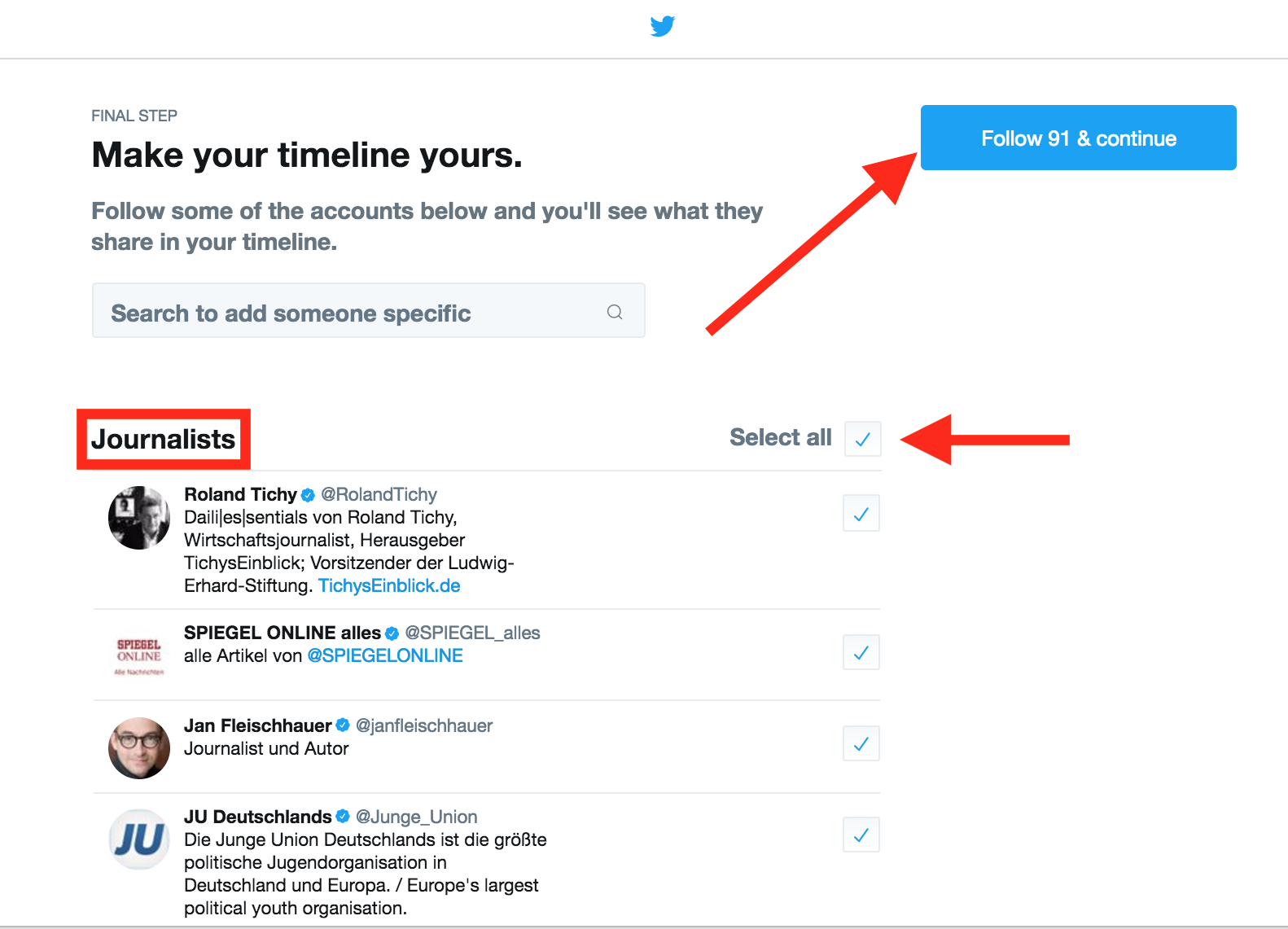
And that right there is the activation point for Twitter users.
Now let’s take a look at how you can find the activation point in your own user onboarding.
Encourage more users to share about you,
Learn how to with The Better Sharing Workbook.
Here’s Everything That Goes Into Defining Your Own Success Milestones in User Onboarding
I’ll admit, it can be a bit confusing to know exactly which feature in your product is the one to create that magic moment for customers.
But luckily for you, it doesn’t need to be a guessing game or a matter of opinion.
That’s because I’m going to show you the exact process you need to go through in order to find your activation point and implement it in your onboarding process.
And it all begins with defining the one action that’s crucial to your customer’s needs.
People often confuse user onboarding with activation, but the two are actually quite different.
Where a user onboarding process may go through several steps and introduce your new sign-ups to many different features and resources, your activation point focuses on a single action that defines your platform’s use case for new customers.
In other words, activation may be just one part of user onboarding.
But it’s without a doubt the most important one.
Here’s what Nick Holmes, marketing director at Nickelled and CEO of Clippings.me, had to say about it on the Inner Trends blog:
“The temptation many people face when designing an onboarding flow is to showcase as much as they can — after all, your product is great and people should see as much of it as possible, right?
Urm, not really. In reality, your customers’ time is precious and the only thing they want is to understand how your product enables them to do what they want to do — and that is why the best onboarding processes are designed with ‘key activation events’ in mind.”
And he’s right – research has shown that it’s better to break down larger tasks (like teaching a new user the in’s and out’s of a complex new SaaS platform) into small wins.
It’s not a new concept – in 1984, Dr. Karl E. Weick of Cornell University wrote about the psychology of smalls wins as they relate to large social issues.
And while we can safely assume Weick wasn’t talking about user onboarding for SaaS companies in his paper, the concepts he outlines should absolutely resonate with app developers today [note, the emphasis is mine]:
“A small win is a concrete, complete, implemented outcome of moderate importance. By itself, one small win may seem unimportant. A series of wins at small but significant tasks, however, reveals a pattern that may attract allies, deter opponents, and lower resistance to subsequent proposals. Small wins are controllable opportunities that produce visible results.”
So to relate that to the world of user onboarding, creating small wins through key activation points helps new sign-ups:
- Quickly become fans of your platform
- Reject the competition
- Be more receptive to upgrades or other sales pitches
Want to see how top SaaS companies do it?
In addition to Trello, Close.io, and Twitter, here are a couple more examples:
Box Encourages You to Invite a Friend
Box – a file sharing service – immediately prompts new users to invite friends to join the platform. If you read the copy on the page, you can see that Box tells you why this is the activation point:
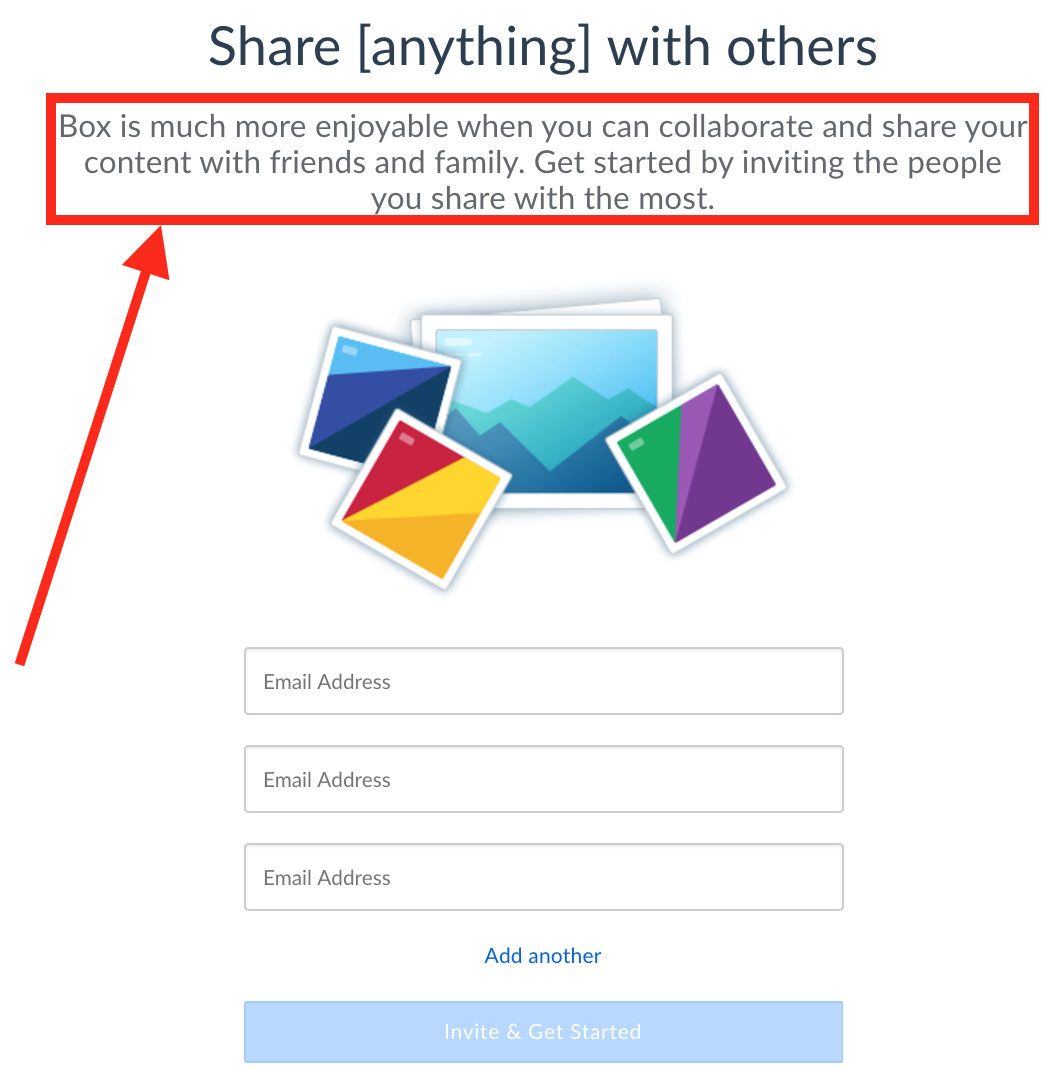
File sharing doesn’t have quite the same punch if you don’t have anyone to share the files with.
That’s why Box encourages you to loop in friends and family before even having you upload your first file.
It’s not the file upload that gives new users that aha! moment – it’s sharing with the people close to you.
Slack Doubles Down on Inviting Coworkers
Work messaging app, Slack, takes the exact same approach as Box, however with an added level.
Here’s what I mean:
When you create a new Slack channel, the first prompt you receive looks and feels very similar to the one from Box.
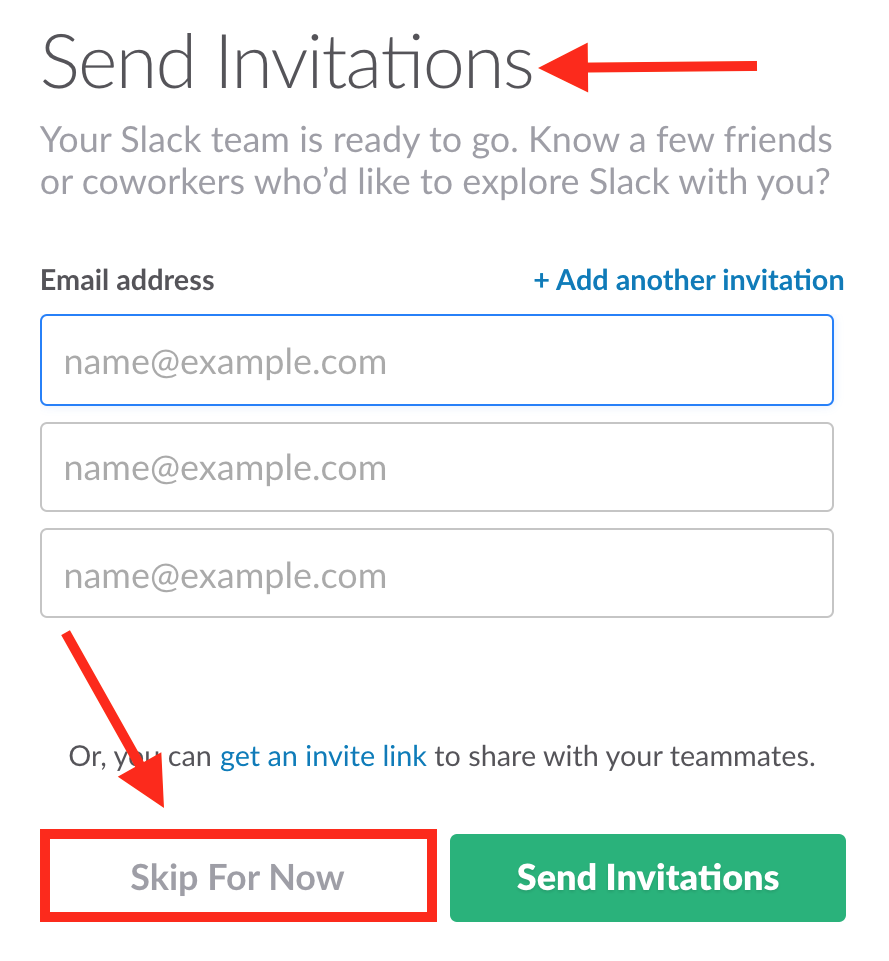
You can skip the step for the moment and get launched into your channel, but take a look at the Tip #3 in the user onboarding walk-through:
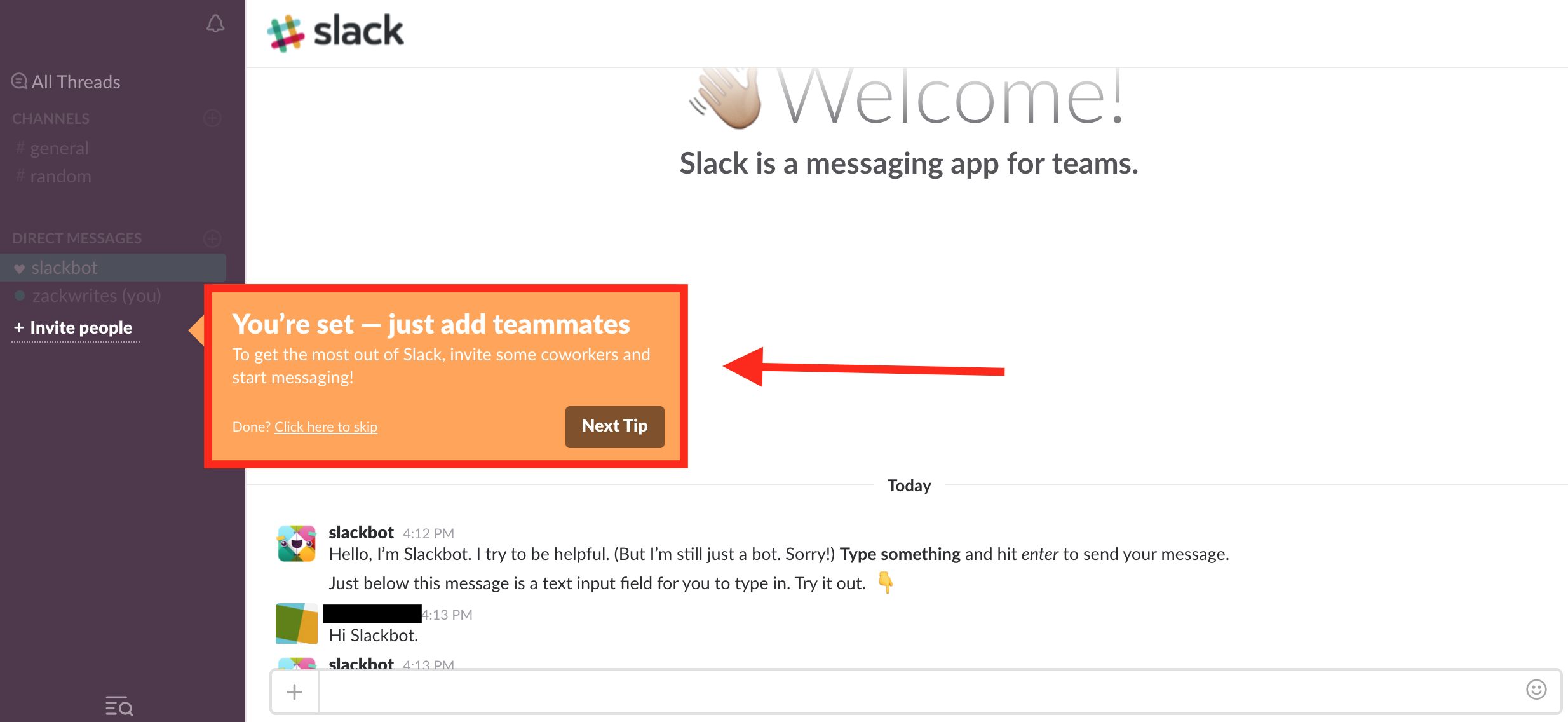
The walk-through prompts you to invite teammates a second time.
That’s because Slack knows the key to keeping you active on the platform is to see how it functions in collaboration with colleagues.
(Chatting with Slackbot is never going to sell you on using Slack.)
So sure, they’ll give you a pass on inviting colleagues in the opening prompt.
But Slack circles back to that activation point a second time during onboarding to make sure you take that critical action – and have that magic moment – before leaving the platform for the first time.
So you see, all the great apps have a truly effective activation point.
But you might be saying to yourself:
Okay, great. But how exactly do I do that?
That’s what I’m going to show you next.
Do a feature audit and optimise your sharing interface,
Learn how to with The Better Sharing Workbook.
Step #1. Define Your User’s Desired Outcomes
Fact: new people sign up to your platform with a very specific goal in mind.
And it’s your job as the developer to lead them to accomplishing that goal as quickly as possible.
But I’m sure you’ll agree with me on this:
Figuring out what your users want out of your app is easier said than done.
Sure, you could invest money in conducting extensive research studies.
But I’m going to recommend a few more cost-effective ways to get the same insights:
1. Talk to your users.
Did you know the co-founders of Airbnb used to go door-to-door and visit hosts to gather customer feedback?
Pretty amazing, right?
In a recent episode of Reid Hoffman’s awesome new podcast, “Masters of Scale,” Airbnb co-founder, Brian Chesky, talked about it:
“It’s really hard to get even 10 people to love anything, but it’s not hard if you spend a ton of time with them. If I want to make something amazing, I just spend time with you. And I’m like, ‘Well, what if I did this?’”
That feedback Chesky gathered ultimately paved the way for some of Airbnb’s most “sticky” activation points, including the peer rating system that often gives new users the confidence to book their first Airbnb (the obvious activation point for their business).
And here’s the thing:
You can do that, too.
Now, I’m not advocating you go knocking on your customers doors.
But you can absolutely survey your users in the same way Chesky and his Airbnb co-founders did to get critical feedback about how they use your platform.
And that feedback can determine the best activation point for new user onboarding.
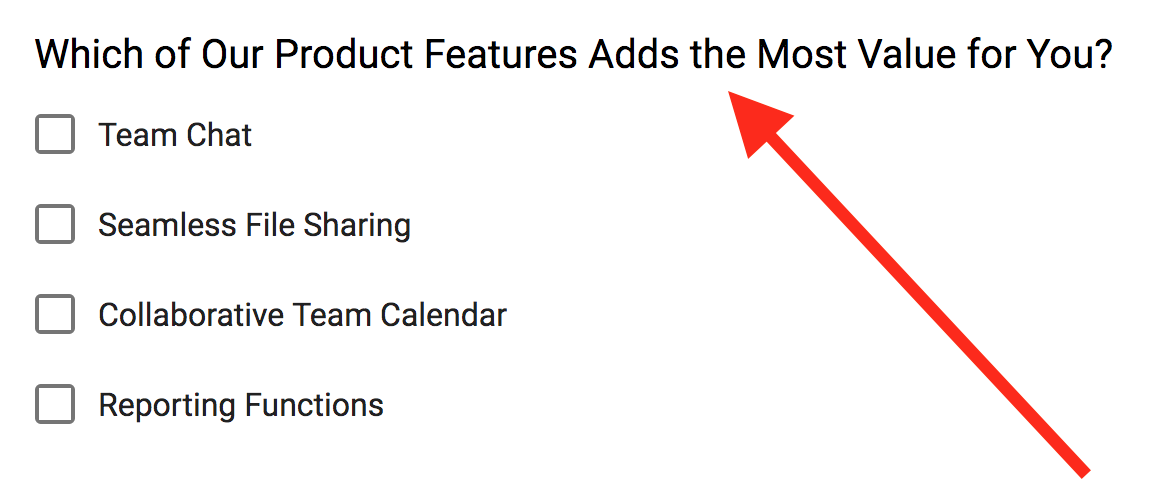
2. A/B test different activation points.
Here’s something you might not have realized: there’s not just one version of Facebook.
In fact, Facebook founder, Mark Zuckerberg, has said that at any given time there are upwards of 10,000 different versions of Facebook you might be using.
That’s because Facebook’s engineers are constantly A/B testing feature sets on small groups of users to figure out what works best for Facebook users.
And while you may not have the ability to scale out 10,000 versions of your app at once, here’s what you can do:
Split-test different user onboarding tracks and activation points.
So, maybe half your new sign-ups get put on an onboarding track that leads them to X activation point and the other half are on a track to Y.
Then, you can measure the customer retention rate for both activation points to figure out which one actually tapped into your user’s goals for your platform.
You with me?

3. Drill down into the data.
In fact, taking a look at your existing customer data should be a first stop for finding your users’ desired outcome.
Think about it:
Anyone who’s currently an active user of your platform has already found the value in your app.
So why not take a deep-dive into your existing customer data to uncover the features adding the most value?
Doing so costs you nothing and gives you a unique perspective into what makes your customers tick.
And that’s a key part of finding your onboarding activation point.
Now, all this talk of data leads nicely into the next step:
Step #2: Find the Metric that Proves Success for You and Your Users
Look: Behind every successful activation point is a solid data-driven metric.
And when new sign-ups hit that metric, the chance of them becoming a return user increases dramatically.
Remember the Twitter example from earlier?
Well Twitter didn’t stumble upon the idea to have you begin following people of interest in the first few moments of signing up – that was a data-driven decision.
Mattan Griffel details the thinking behind this as a success milestone:
“Josh Elman, Twitter’s product lead for growth and relevance until 2011, took a look at their usage numbers and realized that once a user follows 30 people, they’re more or less active forever. If Twitter couldn’t get a person to follow 30 other people, that person was very unlikely to ever come back.”
Facebook’s VP of Growth, Alex Schulz had a similar anecdote about their metric for success (share via Kissmetrics):
“I’ve talked to so many companies, and they try to get incredibly complicated about what they’re doing, but it is just as simple as when you see the first picture of one of your friends on Facebook, you go ‘Oh my God, this is what this site is about!’ Zuckerberg talked at Y Combinator about getting people to 10 friends in 14 days; that is why we focus on this metric.”
So, in short, you need to find your app’s equivalent to following 30 people or adding 10 friends.
It’s not just the action new users need to take – it’s also a threshold that your new sign-ups need to cross to become long-term customers.
For Slack, it would be the number of teammates invited to the platform.
And Trello likely measures the number of boards you create, or number of cards added to a board.
But only your customer data can tell you the right metric for your business – the activation point alone isn’t enough.
Once you know your user’s goals for the platform and have a metric in place, the next step is to map the activation point to your user onboarding process.
Step #3: Breakdown the Onboarding Process
Finding the right activation point for your users is only half the battle – the next step is figuring out how to get new sign-ups to actually take the required action.
And that means taking a good look at your onboarding process to figure out the best way to naturally guide users toward that action, without being overly pushy about it.
That’s especially important when your activation point involves new users sharing their data with you (like Box, Slack, Close.io and even Twitter requested).
Think about it:
Most people want to test out a new platform on their own before inviting others to join.
That’s because they naturally have a fear of making mistakes and don’t want to be wrong if your tool doesn’t end up being the right fit.
And that can be a struggle for companies whose activation point hinges on leveraging user data.
But the good news is, there’s a right way to approach accessing user data.
Take Gainfully for example.
When you first sign-up for the financial networking site, they ask you for some basic demographic information:
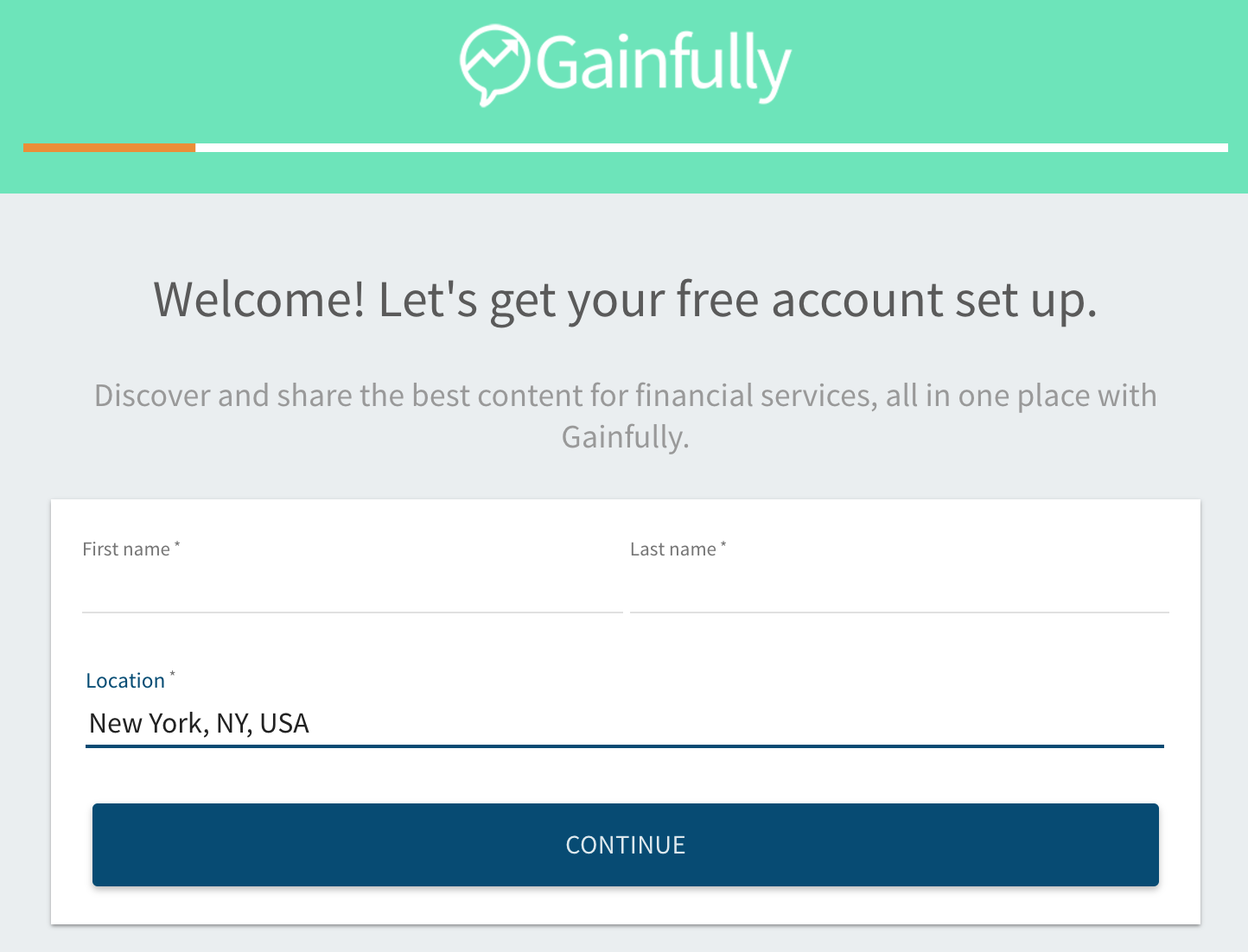
And information about your broker-dealer:
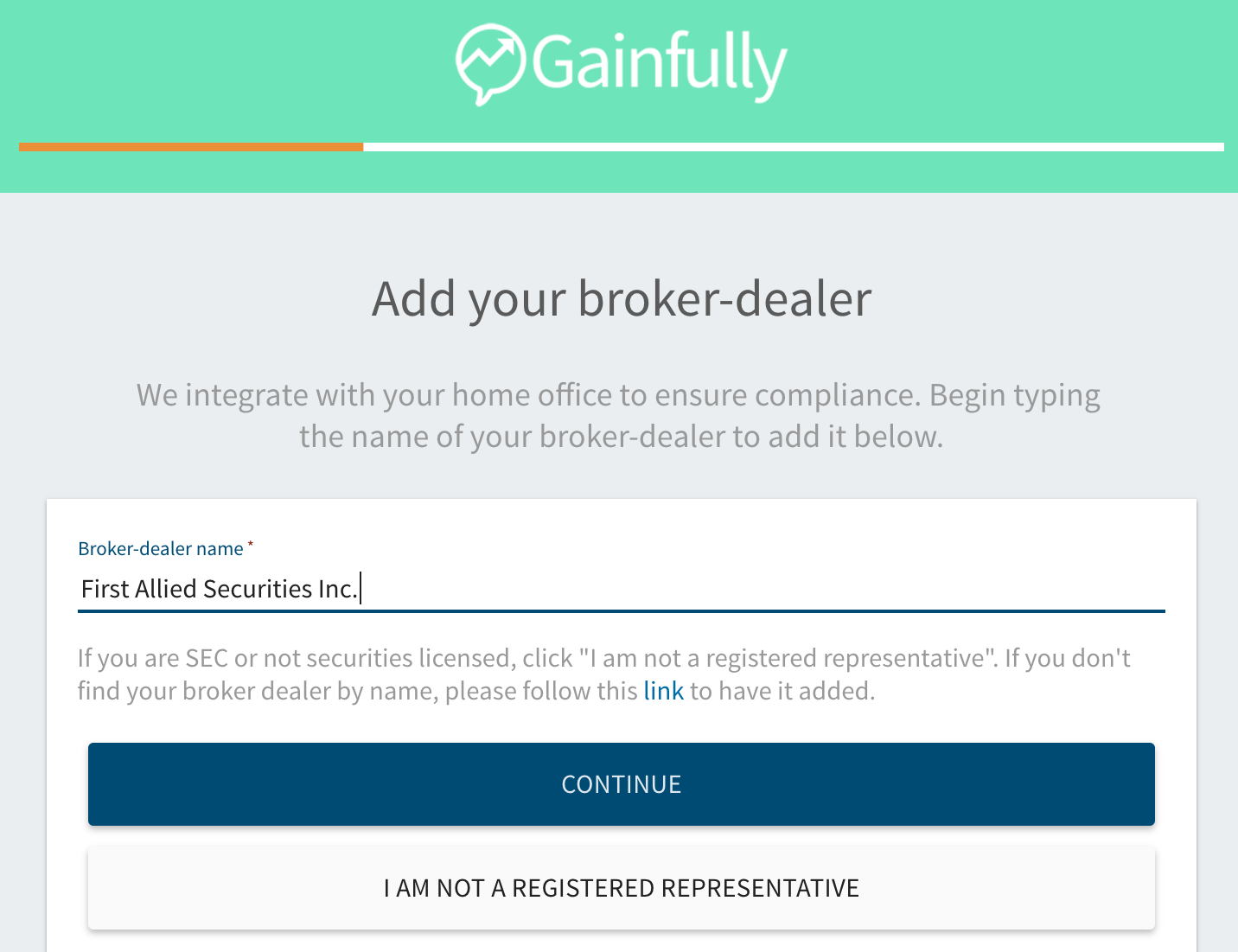
Pretty basic so far, right?
Then, Gainfully digs into the stuff that will really make the platform impactful:
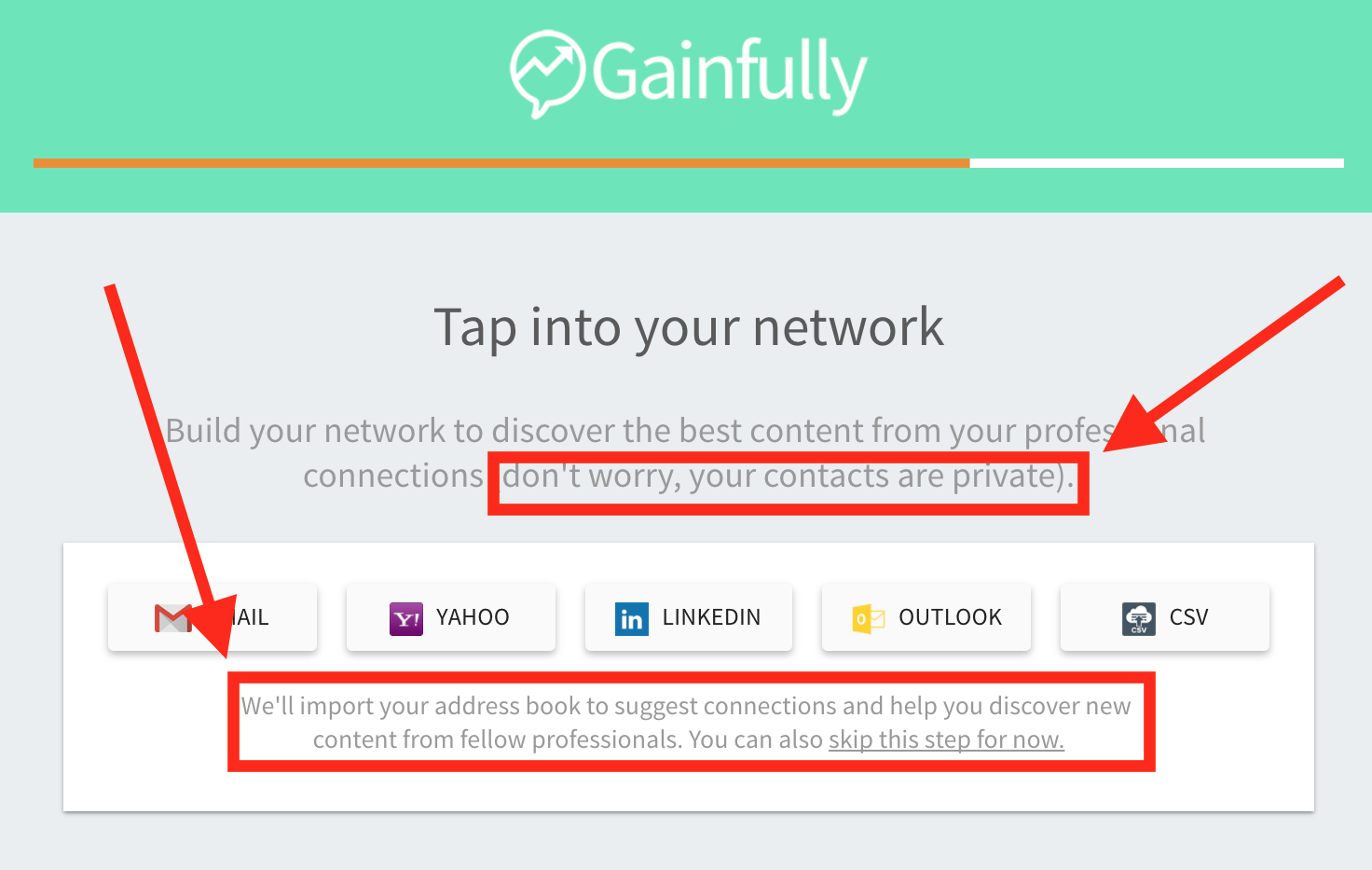
Gainfully’s activation point is getting you to import your address books – something some users may be hesitant to do in the early stages of signing up.
But these guys approach it in an expert way.
First, they lead off by showing you the value you’ll get from taking action (“..discover the best content from your professional connections.”)
Then, they immediately put your mind at ease about data privacy – a big concern when working with someone’s address book.
And finally, they tell you exactly how they intend to use the data and give you the option to opt out.
The result?
Gainfully users have created over 70,000 relationships on the platform as a result of importing address book data.
Want to figure out the best way to have the same results?
Try These Practical Strategies to Lead Users to the Activation Point
#1. Include an Example with Dummy Data (Like Hubspot’s CRM)
Hubspot’s customer relationship management (CRM) platform asks that you import data from your existing CRM to get things started.
It’s a fairly complicated task for some people, but Hubspot makes it easier by including sample .CSV files to show new users how to format their CRM data exports.

#2. Suggest Specific Actions that Guide Toward the Activation Point (Like Nickelled)
Nickelled is actually a platform for creating user onboarding tracks.
So naturally, I was pretty excited to see what their onboarding experience looks like.
And the good news is, they didn’t let me down.
They do an excellent job of suggesting specific steps and guiding new users toward the activation point (creating your first guide):
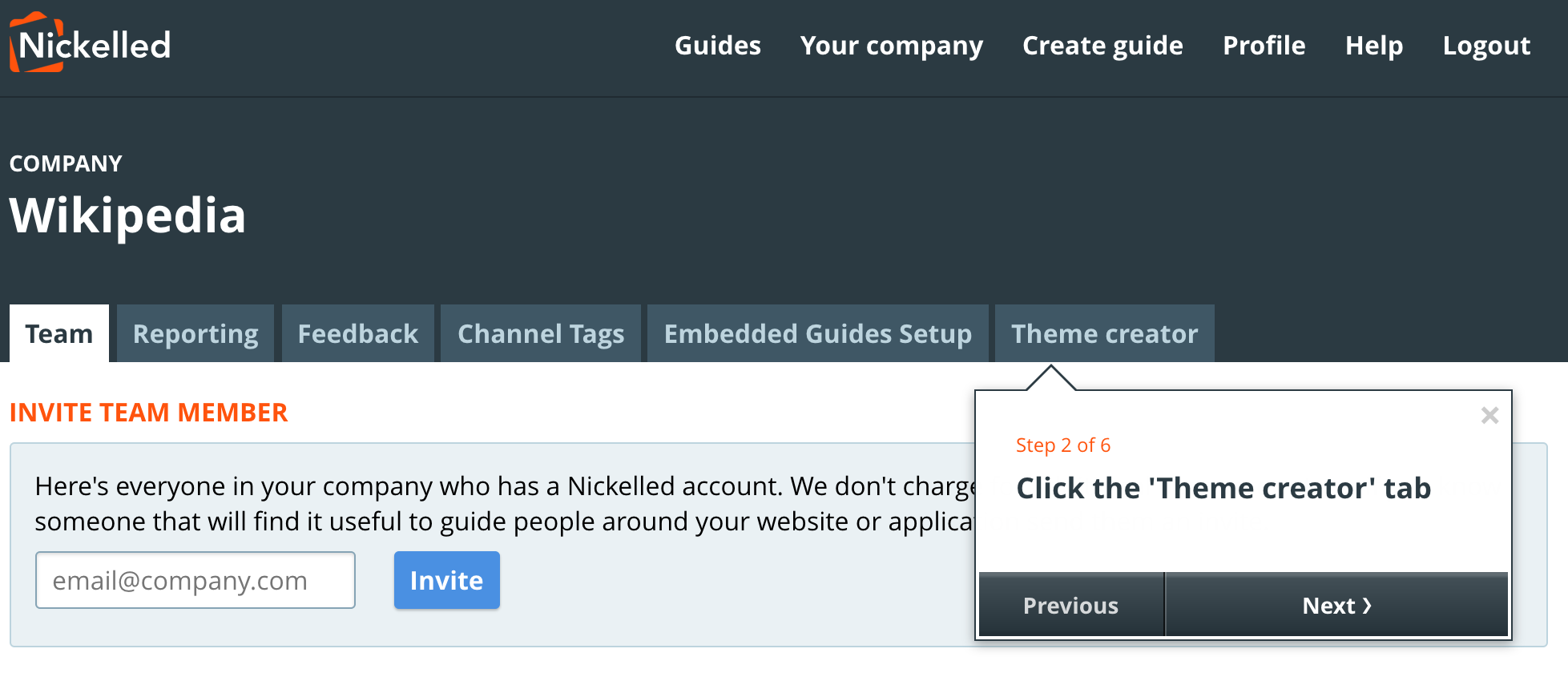
#3. Give a Guided Walk-Through of Features (Like Slack)
Much like Nickelled, Slack has pop-ups walk you through steps towards the activation point when you first get started.
But the big difference is Slack highlights all the major features of their platform, rather than just those associated with the activation point.
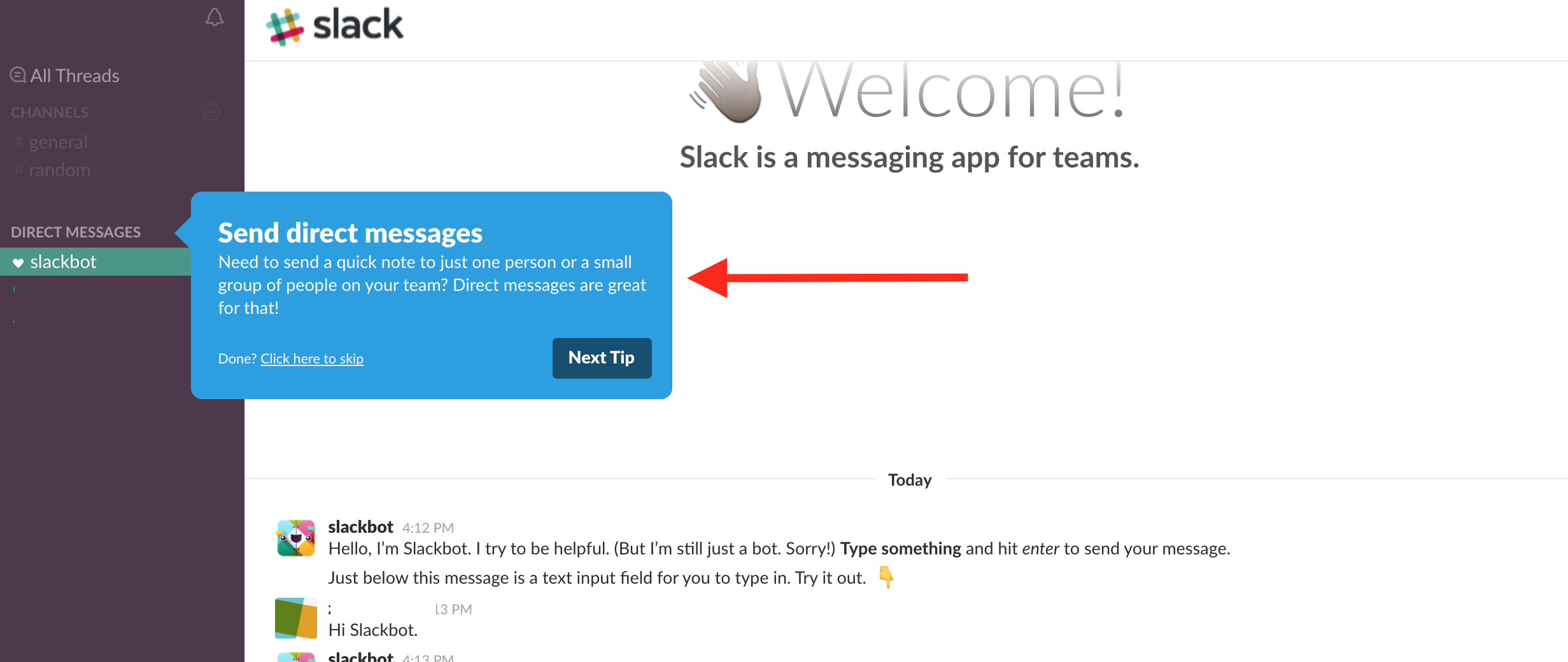
But because each action is small and simple, it doesn’t feel disruptive when in the next tip, they ask you to invite colleagues.
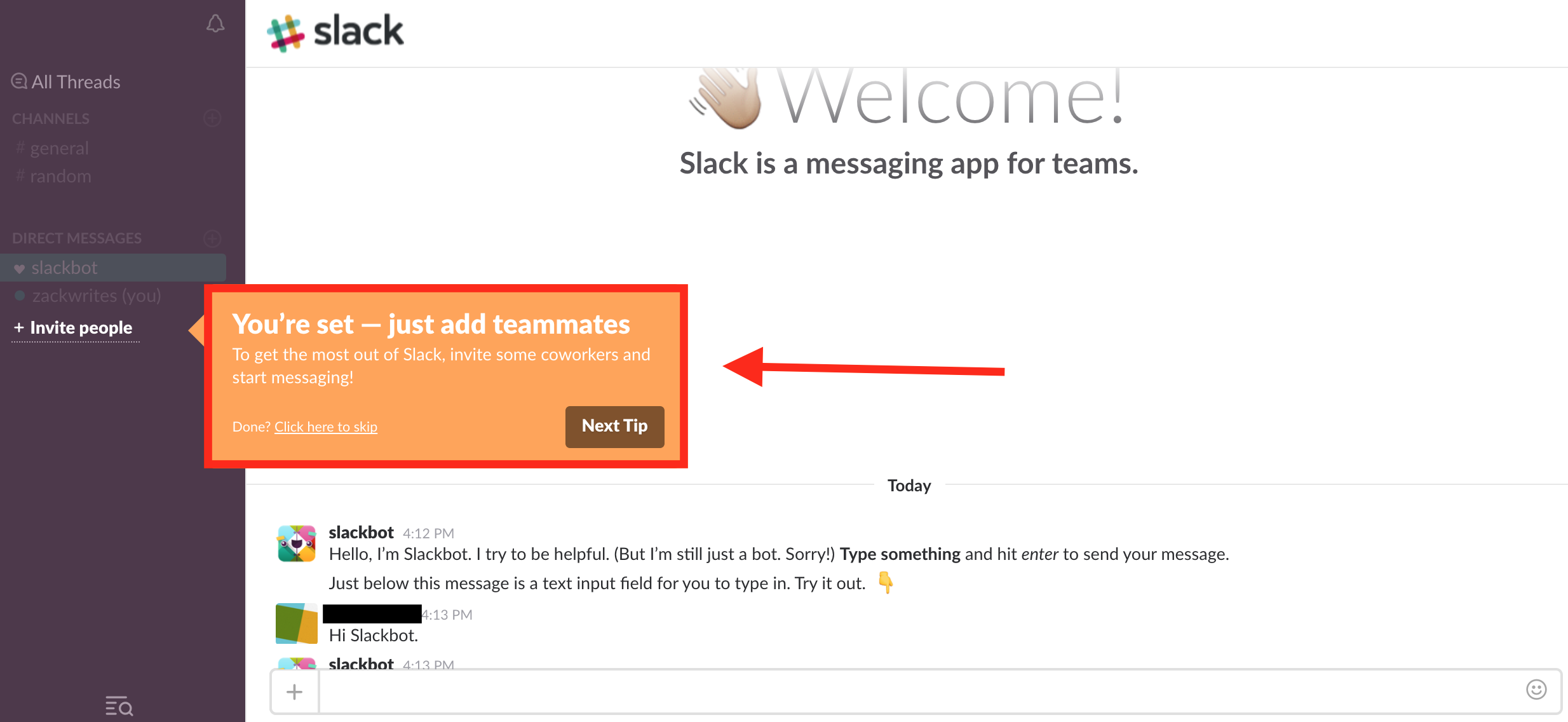
#4. Show Users The Outcome They Desire (Like Canva)
Canva is a graphic design platform that makes it easy to create simple, beautiful graphics for the web or print.
So, because their value is visual in nature, Canva gives new users a taste of the great benefits they can expect by showing them the different types of graphics that you can create:
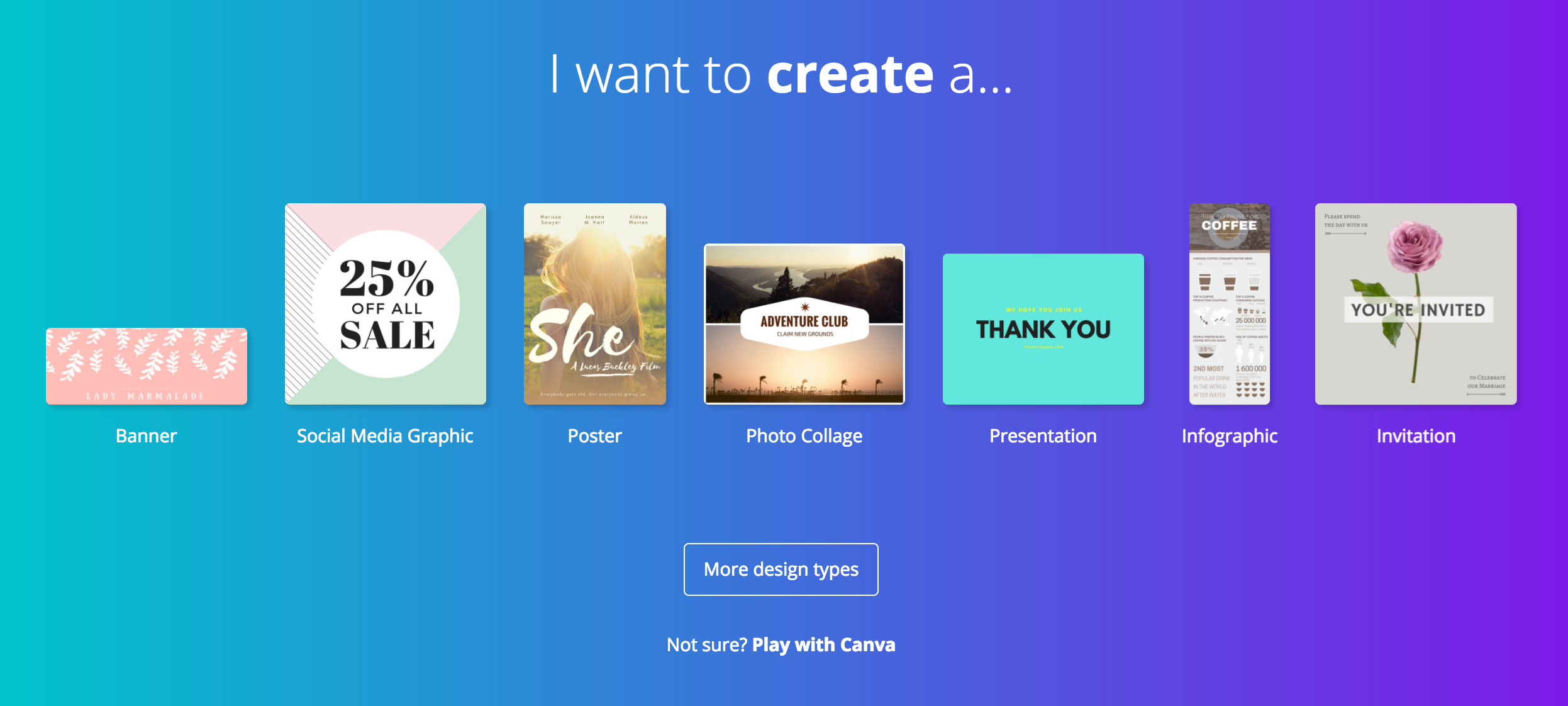
That way, new sign-ups can see right away what their graphic might look like and feel inspired to create one.
What to Do If You Still Struggle with Low Activation
Hopefully you’ve pulled together some new ideas in this guide to help you identify your activation point and improve your user onboarding flow.
But, if you’re still struggling with retaining first-time users, here are a few additional strategies to try:
Identify Your User Onboarding Drop-Off Points
Look, the data doesn’t lie – if you want to know why your users drop-off, find the gaps in your onboarding process and patch the holes.
For example:
Let’s say you’re having a hard time getting customers to import their address book.
In that case, you could try switching up some of the copy (like Gainfully) or positioning the activation point later in the onboarding process.
The idea is to identify where users stop onboarding and then revising that step to help get users to the activation point.
Create a Drip Campaign Around Your Activation Point
I’m sure you require new users to sign-up with an email address, right?
If so, that’s the best way to try and re-engage first-time users who drop-off.
Create an email campaign encouraging users to try specific features that you know will help them see the value in your platform.
Closing Thoughts
Attracting first-time customers might be easy, but retaining them for the long-term is a whole other story.
What’s more, it’s a process that never stops. As Julia Chen pointed out on Appcues blog (note, the emphasis in bold is mine):
“User onboarding is never finished. Gathering user feedback and improving onboarding isn’t just helpful. It’s necessary to providing value, especially as your user base grows and your product evolves.”
Hopefully, though, after reading this guide, you now understand the value of the a strong activation point as part of your new user onboarding and know exactly what you need to do to identify your app’s aha! Moment.
Next Steps
To learn more about how Gainfully used address book imports to completely revamp their onboarding process, read their case study here.
Excited to get started?
Download our Better Sharing Workbook Now
(it's quick, easy and absolutely free!)

